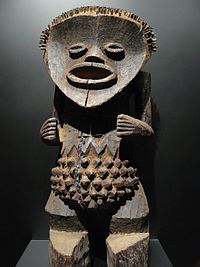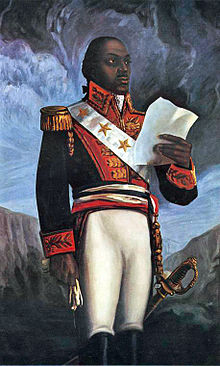Portal:Pan-Africanism
IntroductionWelcome to the Pan-Africanism portal!
Bienvenue sur le portail panafricanisme!   Pan-Africanism is a worldwide movement that aims to encourage and strengthen bonds of solidarity between all indigenous peoples and diasporas of African ancestry. Based on a common goal dating back to the Atlantic slave trade, the movement extends beyond continental Africans with a substantial support base among the African diaspora in the Americas and Europe. Pan-Africanism can be said to have its origins in the struggles of the African people against enslavement and colonization and this struggle may be traced back to the first resistance on slave ships—rebellions and suicides—through the constant plantation and colonial uprisings and the "Back to Africa" movements of the 19th century. Based on the belief that unity is vital to economic, social, and political progress, it aims to "unify and uplift" people of African ancestry. (Full article...) Selected article The Pan-African flag—also known as the UNIA flag, Afro-American flag, Black Liberation flag and various other names—is a tri-color flag consisting of three equal horizontal bands of (from top down) red, black and green. The Universal Negro Improvement Association and African Communities League (UNIA-ACL) formally adopted it on August 13, 1920 in Article 39 of the Declaration of the Rights of the Negro Peoples of the World, during its month-long convention at Madison Square Garden in New York City. Variations of the flag can and have been used in various countries and territories in the Americas to represent Garveyist ideologies. Selected biography
François-Dominique Toussaint Louverture (French: [fʁɑ̃swa dɔminik tusɛ̃ luvɛʁtyʁ] 9 May 1743 – 7 April 1803), also known as Toussaint L'Ouverture or Toussaint Bréda, was the best-known leader of the Haitian Revolution. He was a leader of the growing resistance. His military and political acumen saved the gains of the first Black insurrection in November 1791. He first fought for the Spanish against the French; then for France against Spain and Great Britain; and finally, for Saint-Domingue against Napoleonic France. He then helped transform the insurgency into a revolutionary movement, which by 1800 had turned Saint-Domingue, the most prosperous slave colony of the time, into the first free colonial society to have explicitly rejected race as the basis of social ranking. Though Louverture did not sever ties with France, his actions in 1800 constituted a de facto autonomous colony. The colony's constitution proclaimed him governor for life even against Napoleon Bonaparte's wishes. He died betrayed before the final and most violent stage of the armed conflict. However, his achievements set the grounds for the Black army's absolute victory and for Jean-Jacques Dessalines to declare the sovereign state of Haiti in January 1804. Louverture's prominent role in the Haitian success over colonialism and slavery had earned him the admiration of friends and detractors alike. Selected historyThe Haitian Revolution (French: Révolution haïtienne [ʁevɔlysjɔ̃ ajisjɛ̃n]) was a successful anti-slavery and anti-colonial insurrection by self-liberated slaves against French colonial rule in Saint-Domingue, now the sovereign nation of Haiti. It began on 22 August 1791, and ended in 1804 with the former colony's independence. It involved blacks, mulattoes, French, Spanish, and British participants—with the ex-slave Toussaint L'Ouverture emerging as Haiti's most charismatic hero. It was the only slave uprising that led to the founding of a state which was both free from slavery, and ruled by non-whites and former captives. It is now widely seen as a defining moment in the history of racism in the Atlantic World. Its effects on the institution of slavery were felt throughout the Americas. The end of French rule and the abolition of slavery in the former colony was followed by a successful defense of the freedoms they won, and, with the collaboration of free persons of color, their independence from white Europeans. It represents the largest slave uprising since Spartacus's unsuccessful revolt against the Roman Republic nearly 1,900 years earlier. It challenged long-held European beliefs about alleged black inferiority and about enslaved persons' capacity to achieve and maintain their own freedom. The rebels' organizational capacity and tenacity under pressure inspired stories that shocked and frightened slave owners in the hemisphere. Selected culture  African art describes the modern and historical paintings, sculptures, installations, and other visual culture from native or indigenous Africans and the African continent. The definition may also include the art of the native African, African diasporas, such as African American, Caribbean and other American art. Despite this diversity, there are some unifying artistic themes when considering the totality of the visual culture from the continent of Africa. Masquerade, metalwork, sculpture, architecture, fiber art, and dance are important art forms across Africa and may be included in the study of African art. The term "African art" does not usually include the art of the North African areas along the Mediterranean coast, as such areas had long been part of different traditions. For more than a millennium, the art of such areas had formed part of Islamic art, although with many particular characteristics. The art of Ethiopia, with a long Christian tradition, is also different from that of most of Africa, where traditional African religion (with Islam in the north) was dominant until relatively recently. African art includes ancient art, Muslim art of North and West Africa, the Christian art of East Africa, and the ritualistic art of these and other regions. Most African sculpture was historically in wood and other natural materials that have not survived from earlier than, at most, a few centuries ago; older pottery figures can be found from a number of areas. Masks are important elements in the art of many peoples, along with human figures, often highly stylized. There is a vast variety of styles, often varying within the same context of origin depending on the use of the object, but wide regional trends are apparent; sculpture is most common among "groups of settled cultivators in the areas drained by the Niger and Congo rivers" in West Africa. Direct images of deities are relatively infrequent, but masks in particular are or were often made for religious ceremonies; today many are made for tourists as "airport art". Since the late 19th century there has been an increasing amount of African art in Western collections, the finest pieces of which are now prominently displayed. African mask art has had an important influence on European Modernist art, which was inspired by their lack of concern for naturalistic depiction. West African cultures developed bronze casting for reliefs, like the famous Benin Bronzes, to decorate palaces and for highly naturalistic royal heads from around the Bini town of Benin City, Edo State, in terracotta as well as metal, from the 12th–14th centuries. Akan goldweights are a form of small metal sculptures produced over the period 1400–1900; some apparently represent proverbs, contributing a narrative element rare in African sculpture; and royal regalia included impressive gold sculptured elements. Many West African figures are used in religious rituals and are often coated with materials placed on them for ceremonial offerings. The Mande-speaking peoples of the same region make pieces from wood with broad, flat surfaces and arms and legs shaped like cylinders. In Central Africa, however, the main distinguishing characteristics include heart-shaped faces that are curved inward and display patterns of circles and dots. Selected imagesOrganisationsAll-African People's Revolutionary Party · African Society for Cultural Relations with Independent Africa · African Unification Front · African Union · African Queens and Women Cultural Leaders Network · Conseil de l'Entente · Convention People's Party · East African Community · Economic Freedom Fighters · Global Afrikan Congress · International African Service Bureau · International League for Darker People · Organisation of African Unity · Pan African Association · Pan-African Congress · Pan Africanist Congress of Azania · Rassemblement Démocratique Africain · Pan Africa Chemistry Network · Pan African Federation of Accountants · Pan-African Freedom Movement for East and Central Africa · Sahara and Sahel Observatory · UNIA-ACL · ZANU–PF
See also
& Festivals Photo by Helinä Rautavaara (1977) Publications
Films and TVAudios and videosDid you know ...that A. F. James MacArthur (pictured) broadcast his standoff with the Baltimore Police Department to 10,000 online listeners?
Selected quotesIn his "Whirlwind Message", the First Message to the Negroes of the World from Atlanta Prison (10 February 1925), Marcus Garvey delivered the following message:
Pan-Africanism topicsCategoriesThings you can do
Related portalsAssociated WikimediaThe following Wikimedia Foundation sister projects provide more on this subject:
Discover Wikipedia using portals | |||||||||||||||||||||||||||||||||||||||||||||||||||||||































